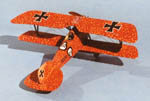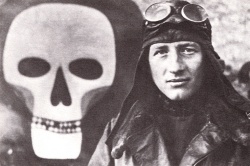 |
About the real aircraft
A very brief history of this aircraft and its pilot:
Type Modeled:
Oeffag Albatros D.III Series
153
Improved over their German cousins with a strengthened airframe and powered by Austro-Daimler engines, the Oeffag Albatros fighters built under license at Wiener-Neustadt were the best fighters used by the Austro-Hungarian air service. Series 153 aircraft were equipped with 200 hp Austro-Daimler engines and were armed with two Schwarzlose machine guns.
Serial/Unit:
153.45*
of Flik. 41J, Austro-Hungarian Luftfahrtruppe
153.45 was flown by Hauptmann
Godwin Brumowski, leader of Fliegerkommpagnie 41J, an elite fighter
outfit based at Torresella from November 1917 to February 1918. Avoiding the
issues concerning the attribution and tallying of confirmed victories, lets
just say that Brumowski was credited with 35 victories, scoring 8 of them
in 153.45, and is considered Austria-Hungary's ace of aces.
* See below!!!
Why this aircraft?
Viewing photographs of actual period aircraft is the most consistently stimulating factor driving my interest in World War One aviation. My interest in modeling these fascinating planes is in large part an effort to make the images come to life, in a tangible and creative process. Even my least competent modeling efforts give me the satisfaction of working material, shape and color into the form of the aircraft pictured. When thinking of possible subjects for the Albatros cook-up, this picture of two Albatrosen was one of the most compelling to me. This indeed is probably my favorite WWI image:
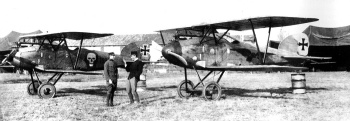
What is pictured?
This shows two Oeffag Albatrosen of Flik. 41J with their pilots at Torresella, December 1917. On the left is Brumowski and his Series 153 Albatros (see below) and on the right is Oberleutant Frank Linke-Crawford, credited with 27 victories, and his 153.16.
Why this picture?
This photo has many elements which are of interest: First, it is an attractive image in composition and tone, and fairly clear. Next, it shows Austro-Hungarian subjects, and so is relatively fresh. Also, though I have interest in all aspects of the Great War in the air, A-H aviation is of special interest to me. Two Albatosen - in my opinion the Albatros series of aircraft have to be considered the central design of the war, historically and aesthetically. The two pictured are indeed notable both historically and aesthetically. Two aces: the concept and fascination for aces is not only for enthusiasts, but is perhaps the only legacy of the Great War to still have any currency in the cultural scene today. World War II has trumped the Great War in military/technological/political interest, but many still know of the Red Baron and are familiar with the ace as a measure of individual skill, toughness and aggressiveness. Markings: both aircraft have distinctive and eye-catching visuals.
So...having already completed a model of Linke-Crawford's 153.16, Brumowski's Albatros was the clear choice for the cook-up.
But is it really 153.45?
Very quickly upon starting research, I discovered that most sources list the subject aircraft pictured as Brumowski's 153.52, which he flew during the same period as 153.45!
What do we know for sure?
This may not be etched in stone, but there seems to be a consensus that between Autumn 1917 and Summer 1918 Brumowski flew 3 Albatrosen that were overpainted red: 152.45, 152.52, 153.209. These 3 all sported skulls on the sides and top of the fuselage, just behind the cockpit. The skulls were similar but unique to each plane. 153.52 definitely also had yellow ochre sworls over the red, in a similar fashion as applied over a green background on other Albatrosen. This is attributed to Brumowski who first tried this camouflage style on of his Hansa-Brandenburg D.I fighters. Pictures of 153.209, which he flew later during Spring/Summer of 1918 show no sworls, along with a white field behind the rudder cross, so it all comes down to 153.45 or 153.52. This photo of 152.52 shows the red overpainting, the yellow sworls, the skull and the serial clearly:
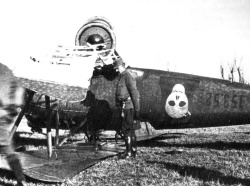
Another photo!
To complicate matters, here is a photo where the plane is identified in all sources as 153.45, after a fire. There don't appear to be sworls!!! Hmmm...the skull looks like the subject plane, but could there really be sworls that simply are not visible in this photo?
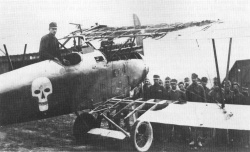
What do the references say?
Here is a table showing the reference material I used and their take on these two red planes of Brumowski:
| Book | 153.45 | 153.52 |
|
Air Aces of the
Austro-Hungarian Empire/ |
Identifies picture immediately above as 152.45, and profiles 153.45 as red overall, no sworls |
Identifies my subject plane in picture as 152.52 |
|
Insignia Issue 5 March/April |
Also illustrates 153.45 as red overall, no sworls |
Profiles 153.52 as red with sworls |
|
Windsock Datafile #19 Albatros D.III (Oef)/ Grosz/Colours & Markings by Rimmel |
Identifies above picture as 152.45 |
Identifies crash photo as 153.52 |
|
Die Albatros (Oeffag) Jagdflugzueg der Kuk Luftfahrtruppen/Schiemer |
n/a |
Identifies crash photo as 153.52 |
|
Albatros D.II & D.III (Oeffag)/Tesar (JaPo) |
Identifies subject plane in picture as 153.45, only source to do so, and only source to claim both planes had yellow sworls. Not profiled |
Profiled red with sworls |
Why I go with 153.45
The skulls are different. In the above photo of 153.52, the serial number is definitely 153.52, and the style of skull is very clear. Looking at the subject plane,
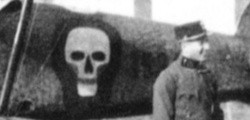
one can see its skull is not the same as the skull on 153.52. There no evidence that I know of that indicates 153.52 had two seperate styles of skull on each side of the fuselage, or if they were changed at some point, which could account for the difference. The black surround behind the skull also differs between the photos. On the subject plane it roughly follows the skull outline, on the photo of 153.52, it widens toward the bottom.
Summary
Inconclusive. Unfortunately, Brumowski is standing in front of the last two digits of the serial number, thus preventing positive identification. Comparing the upper left part of the digit over his shoulder to the discernable '5' in '153' is inconclusive. It appears to be at an angle like a '4', but the corresponding part of '5' also looks at an angle. For me, the difference in skulls is more compelling then the apparent absence of sworls in the 'fire ' picture.
Other opinions?
Any opinions on the identity of these planes is welcome. Any credible evidence not covered here or differing evaluation is even more welcome! I know this will not be as volatile as subject as the cowling color of Voss's triplane, or the colors/markings of the M.v.R deathplane, but I am interested!
The Build
The kit,
and its building:
1/72
Oef. Alb. D.III Series 153 by HitKit
I was glad to see the appearance of the HitKit Austrian Albatrosen as a somewhat less expensive alternative boasting many decal options to the Pegasus kit. Upon starting the build, however, I was unimpressed by the soft plastic and the extensive amount of flash covering everything. The kit's engine, wheels, and struts would have required much time and effort to make acceptable and so are best replaced by aftermarket items. I obtained Roseparts 200hp Austro-Daimler engine and 10mm wheels (both resin) from Berry at Rosemont Hobbies and used Evergreen strip stock for struts. All parts needed much clean-up and sanding. The upper wing ribs are quite crude and probably should be sanded down and replaced, although I did not do so in the interest of cutting down on the build time, hoping the camouflage of 153.45 (or .52!) would make it less noticable. I made a cursory check of accuracy by simply comparing the fuselage and flying surfaces to the Ian Stairs plans in the Datafile which matched up well, and the overall 'look' seemed fine to my eyes. The kit also included photo-etched details, some of which seemed a little too large for the scale, but I selectively used some of them. A markings notes sheet was also included with small line art profiles and a paragraph or so on each decal option, although as the above relates, I decided to reject the notes concerning 152.45 and 153.52.
Cockpit
The fuselage walls are too thick - nothing new there - and of course the cockpit floor does not fit. Not having implements brutal enough to properly thin the fuselage, I did some sanding and a lot of chopping, scratched some crude fittings, and used one of the two instrument panels from the photo-etched sheets (both matched well to various cockpit photos) to come up with a 'rough sketch' of a cockpit. I'm no Alberto! The cockpit coaming also had to be redone, and I used the photo-etched windscreen frame.
Construction
As on all Albatrosen I've built, the attachment of the stabilizer/elevator unit required much adjustment - I'm not sure if this is because of inaccuracies in the mouldings or sloppiness in my constuction; both are possible. The other problem area was mounting the engine in the proper position, which also required a lot of work. The panel surrounding the engine had to be reworked and the final result turned out acceptable if not 100% accurate - close enough for jazz. The attachment of the wings and struts (using my own struts) went smoothly. The final touch was to use a Martin Digmayer hand-made propeller obtained through Copper State Models.
Color/Markings
It has been suggested that Brumowski's visit to the Western Front prompted him upon return to adopt red as a personal motif following Richtofen's example, and the first question was to decide what sort of red to use for the overpainting. As in all color matters, there is much speculation and little that can be stated without reasonable objection. Early A-H aircraft often carried red bands on the wings, tailplane, and sometimes the fuselage; one can conjecture that this would be in the fashion of a flag, such as the Italian wing markings in place of roundels, and so the red would presumably be a bright red as seen on flag and banners. Perhaps Brumowski's ground crew would have access to the same stores of red. Although I am guessing a 'flag red' for Brumowski's aircraft, I think in 1/72 scale a slight but definite toning down in tint and shade is neceessary to achieve the right look. Having been converted to using Delta Ceramcoat acrylics by Bob Pearson, I went to the local craft store and quickly selected 'Morrocan Red' - a bit darker then an insignia type of red but not too dark, and in the middle range tint-wise. When reproducing overpainting, it is always tricky to decide how opaque the top coat should be. Although I usually opt for complete coverage, this time I decided to try applying coats until it looked right to my eye, based on comparing it to the plane's appearance in the photos. I first painted the model in natural factory finish: clear-doped linen, varnished wood (which seems to be very light in photos of natural finished A-H aircraft) and metal panels. After applying 5-6 thin coats, I was happy with the result, especially where the metal panels still show through the red.
Next, the sworls: the decal sworls looked great on the sheet but a test proved that the yellow sworls did not show up well against the red background. Also the decal film is both flimsy and thick at once; the thickness would be a problem with the sworl pattern: the sworls are reproduced in a regular grid pattern, however the photos show the application was irregular. One would have to cut out small sections of sworls and rotate them - the overlapping would look terrible and out of scale. I then decided there was no alternative to doing it like the original - to apply each sworl one at a time. I then used Partha Paints 'Dun' for the yellow ochre sworls and set about trying to duplicate the effect shown most clearly in the photo above of 153.52. I eventually used balsa strip, sanded to a point, and applied the sworls in groups of around 10, trying to maintain a consistent technique, allowing the decreasing amount of paint on the point to result in the varying tone of each sworl. I was trying to achieve an effect of having an overall look of many lightly applied sworls with a lesser amount of sworls that were heavily applied standing out distinctly. This came out looking ok to my eyes but didn't reproduce well in the photos of the model. Perhaps I could had painted more, smaller sworls instead of fewer, larger ones.
As noted above, the kit includes personal markings for several A-H aircraft including both 153.45 and 153.52, national markings, and a sheet of 2 varieties of the the Brumowski sworl pattern. However, in addition to being wary of the decal's strength, I didn't think the skulls looked close enough to the subject aircraft, so I turned to the recently obtained set of SuperCal Ink Jet decals (http://www.paper-paper.com/). I scanned the skull, manipulated the look and size of the image in Photoshop until the test printing on plain paper looked right. I then taped the decal sheet to a sheet of photo paper and it printed out fine. It is sealed with a spray of some probably horribly noxious chemical (the spray can is included in the SuperCal package), and although thick, the newly created skull decals went onto the fuselage with no problem. For the serial numbers, I used the Blue Rider sheet of A-H serial numbers. Having to apply individual 4s & 5s; the result is certainly no winner of contest judging points - I am just now starting to work with Future as a decal setting agent, and realized too late that I didn't know how to move the decals once placed on the model -any advice? I had the same problem with the crosses, as some of the kit crosses broke apart. Not for the first time on this project, I opted to save time in order to finish sometime this year by taking a short cut: I decided against removing and replacing the messed up decals , but did a rough touch up on the crosses by hand.
Rigging
This is another area of modeling which I am currently trying to develop. I've used wire for the Hobbycraft 1/32 kits I've built, tried many times without success to stretch sprue, finally Dennis Ugulano's DURAS method seems to be something I can do! I did a passable job on the 1/48 Eduard Morane N, so with more practice I think it will be alright. This was my first attempt at rigging in 1/72; it is not perfect but is something to build on!
The Pics
My first attempt at photographing my models proved to be a struggle with both material and technique; depth of field being the most trouble. List member Lee kindly gave some advice and offered his help, which I will gladly accept for the next time around. Yet, the results were presentable, and you can see for yourself. The sworls applied with less paint do not show up well in the photos.
In Conclusion
Going into the cook-up, I had hoped to take my modeling skills up a level or two. This project was a challenge in all respects: research/documentation, dodgy kit, learning new techniques, all with unexpected time restraints. With that in mind it was a qualified success for my personal level in modeling, and the two aspects which most interested me in modeling this aircraft, the sworl pattern and the skulls, are reasonably close to the subject.
For those seeking to model the Oeffag Albatros in 1/72, I think the Pegasus kit is a better choice; hopefully Roden will throw its hat into the ring as rumoured and provide us with another option.
